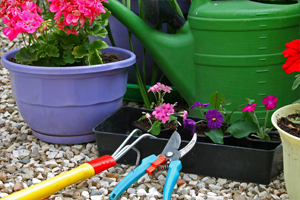 Gardening is hard work! It can put quite a strain on your muscles, especially those in your back. If you don’t garden regularly, be sure to start slowly and work your way up to longer gardening sessions. Here are some suggestions for making the most of your garden while treating your back with care.
Gardening is hard work! It can put quite a strain on your muscles, especially those in your back. If you don’t garden regularly, be sure to start slowly and work your way up to longer gardening sessions. Here are some suggestions for making the most of your garden while treating your back with care.
First, be sure to warm up your back muscles with some stretching before you go out, particularly in colder weather. Gardening may involve significant reaching and twisting, so perform some of those moves gently indoors before heading out. Be sure to keep water nearby and to take breaks often. If you start to feel any pain, stop and rest. Otherwise, you risk injuring your back and making it impossible for you to do anything at all in your garden.
Garden Layout
- Use mulch on the surface of your garden and avoid leaving bare spots. This will reduce weeds and help the soil retain moisture, so you don’t have to water as often.
- Use raised flowerbeds, which are both attractive and help reduce the need to bend down. You can grow vines and other trailing plants around the edges.
- Make sure your flowerbeds are narrow enough that you don’t have to reach too far over them.
Plants
- Remember that slow-growing shrubs are less trouble to maintain than perennials or annuals.
- Use fruit trees grown on dwarf rootstocks. This will allow you to pick fruit at a reasonable height.
- Consider ground-covering plants to keep weeds under control. Weeding is hard on the back due to all the bending over.
Tools
- Use forks and trowels with long handles, and other tools with extenders to reduce your need to reach.
- Make sure your pruners and loppers are sharp and have ratchet systems. Cutting will be easier and there will be less strain on your back and shoulders.
- Get a holster for secateurs and attach it to your belt, so you don’t have to keep reaching down to pick them up.
- Avoid heavy watering cans for irrigation. If you use a can, only fill it half way.
How to reduce digging
If you spread compost and fertilizer or manure over a flowerbed surface in the late autumn, the soil has time to settle before spring planting. Worms will take organic matter into the soil and you won’t have to dig so much. This approach requires initial digging to level the soil and remove weeds, but over time you will be able to dig less and less. Many gardeners feel that this method is better than traditional “double digging” because it leaves the soil structure intact. Contact a specialist at your local gardening center for more details on this back-saving approach to gardening.














